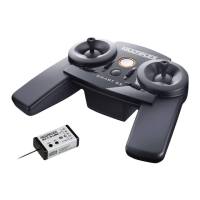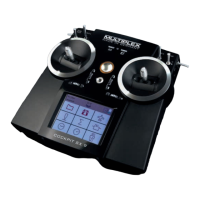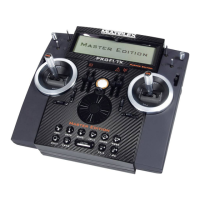ROYAL SX
36
12.4.2. Checking / changing the direction of
servo rotation
It is important to check the direction of rotation of the
servos and correct that aspect (if necessary) before
making adjustments to the centre position and travels.
Checking:
Move the transmitter controls for the individual control
functions in turn (aileron, elevator, rudder), and check
whether the control surfaces move in the correct di-
rection.
This is the procedure for altering the direction of
rotation:
a. Open the main menu ¤Servo
(press button ¤).
b. Open the Calibration menu (Calibrate)
and select a Servo.
c. Select line á and open Parameter:
¤Calibr.AILERON+
¨Exit
á
0
Now you can reverse the direction of servo rotation
using the REV/CLR button. The effect is immediate-
ly visible in the graph (curve reverses).
Tip:
If you move the associated stick slightly away from
the centre position and then press the REV/CLR
button, the servo will jump to a new position when
you reverse it. This is an easy way to check that
you have selected the “right” servo.
d. When the direction of rotation is correct, press the
3-D digi-adjuster or the ENTER button to confirm
your choice, then quit the menu via Exit and se-
lect the next servo you wish to adjust.
!
Note:
Please don’t start adjusting servo travels and centre
positions until you have corrected the direction of rota-
tion for all the servos. If you subsequently reverse the
servo, you will need to carry out the calibration pro-
cess again.
12.4.3. Calibrating servos
= setting the centre and maximum travels
In the menu ¤Servo.Calibrate ( 11.7.) you can
adjust the travels (P1 and P5), the centre positions
(P3) and the intermediate points (P2 and P4) for all
servos in such a way that the servos take up the cor-
rect idle position, move evenly across their range of
travel, and reach the appropriate end-points.
!
If you wish your models to fly accurately, precise
servo calibration is a fundamental requirement!
!
The travel you set at this point cannot be ex-
ceeded (travel limit).
!
Always set the largest travel which the servo will
be required to carry out.
Example: when the ailerons are raised for glide path
control, the ailerons deflect up by 20 mm, but only 12
mm deflection is required for AILERON control. If the
ailerons are used as camber-changing flaps, the re-
quired travel is just 3 mm. At the calibration stage
point P1 (and P5) must be adjusted so that the aileron
travel is 20 mm.
This is the procedure for adjusting servo centre:
a. Open the main menu ¤Servo
(press button ¤).
b. Open the Calibration menu (Calibrate)
and select the servo.
c. Select line P3 and open Parameter:
¤Calibr.AILERON+
¨Exit
á
0
P1 -100%
P2 ---
P3
0
%
P4 ---
P5 100%
!
Note: first carry out a hardware “calibration”!
Now press button F. This generates the “true” cen-
tre, without the influence of the trim or mixer inputs on
the servo.
If the servo is not in the desired centre position at this
stage, it is essential to correct the control surface po-
sition mechanically (by re-positioning the output arm
on the servo, or otherwise adjusting the linkage).
Wherever possible, the fine-tuning for Point P3 of
servo calibration should not exceed ±15%.
d. Now use one of the two 3-D digi-adjusters to set
the control surface to the desired centre position.
Any adjustments you make are immediately visible
on the model itself.
e. When the centre point is correct, press the 3-D
digi-adjuster or the ENTER button to confirm, quit
the menu via Exit, and select the next servo you
wish to adjust.

